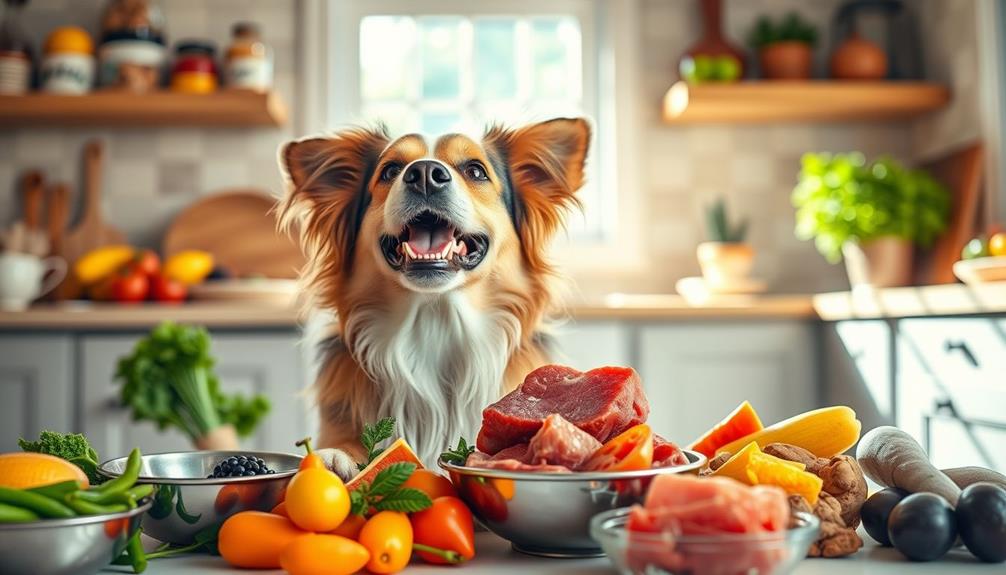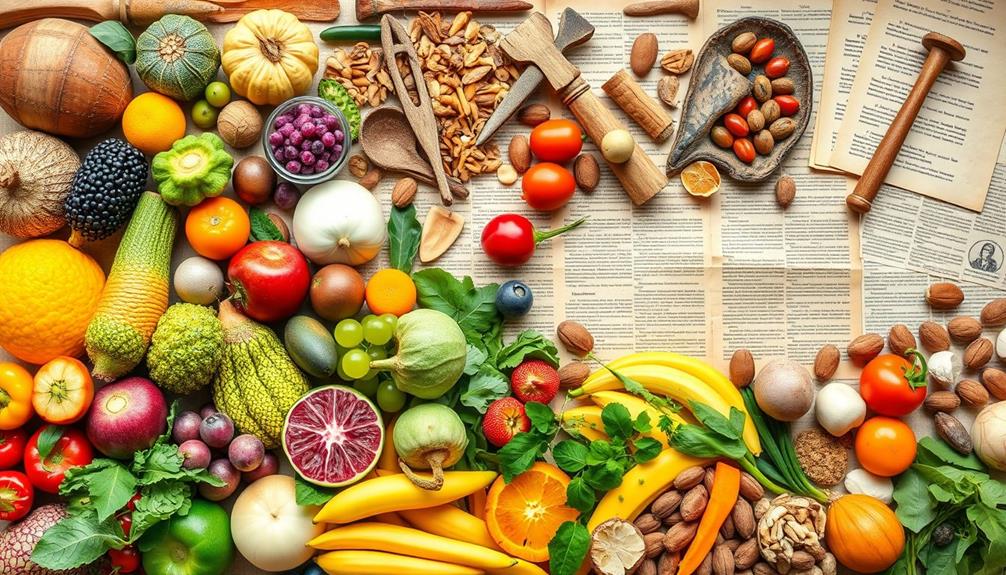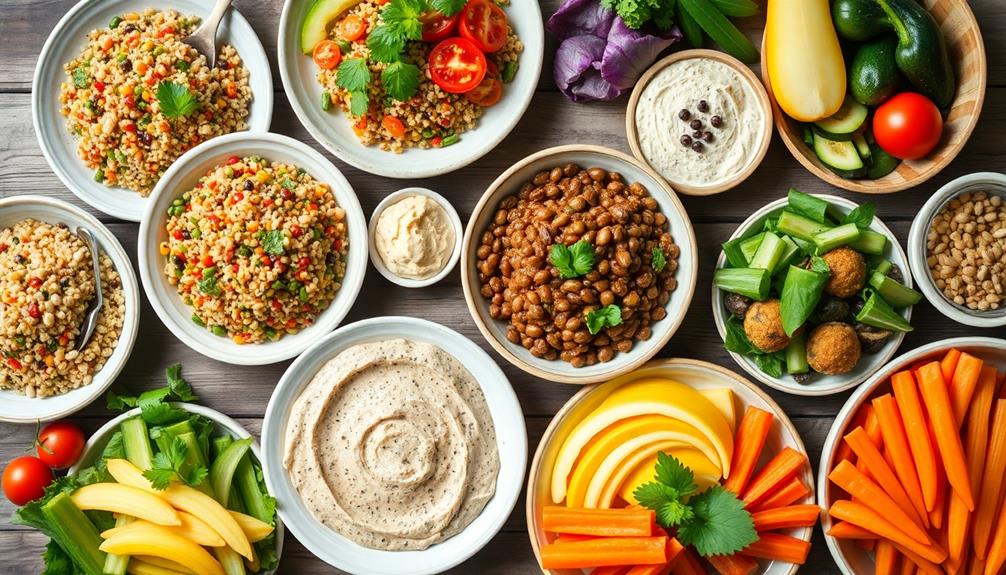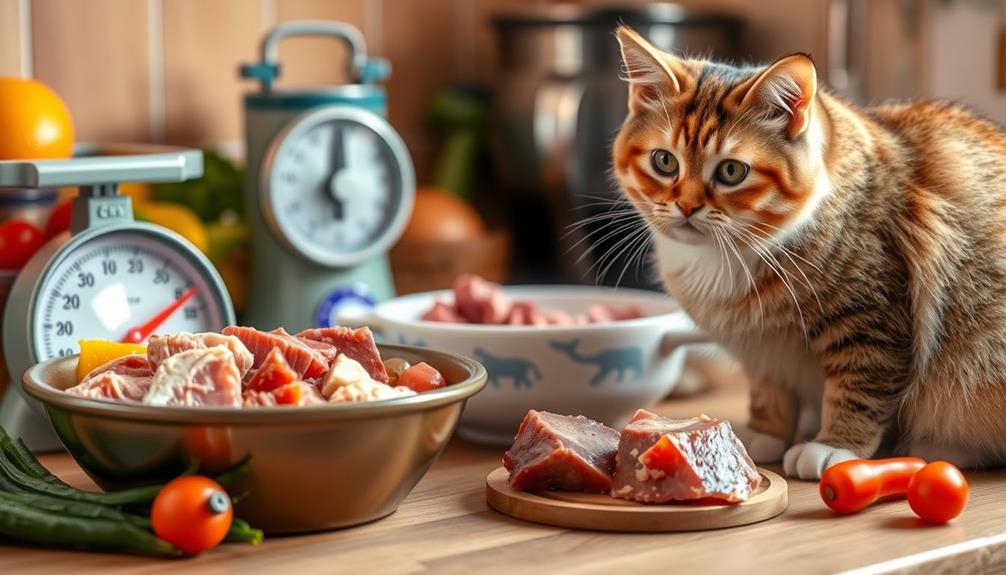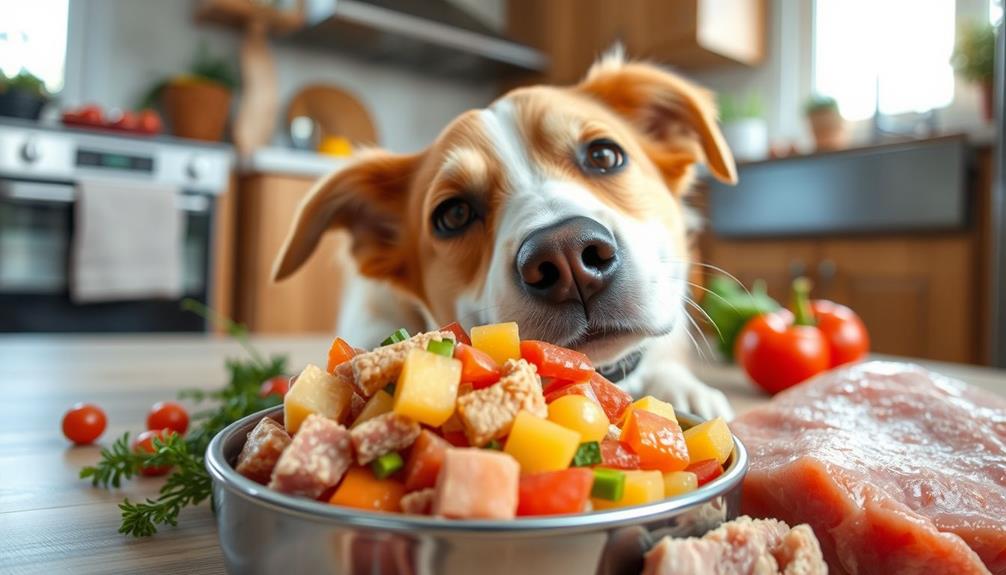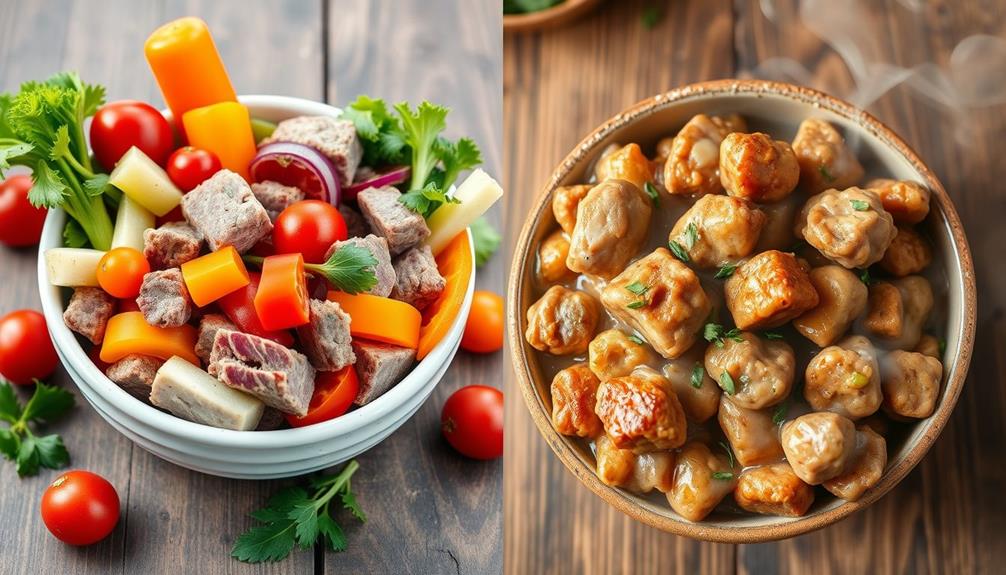Feeding your dog raw food can greatly boost their health and energy. You'll notice improved digestion leading to firmer stools, and your pup's coat will shine brighter and feel softer. Raw diets often reduce allergies and strengthen their immune system, which helps fend off illnesses. You might also enjoy better dental health for your dog, with less plaque and fresher breath. Plus, a raw food diet can support weight management and keep your pup active and vibrant. For more insights on how raw food can transform your dog's life, there's plenty more to discover.
Key Takeaways
- Raw food diets improve digestion, leading to firmer stools and reduced odor while alleviating gastrointestinal issues.
- Enhanced skin and coat health is achieved through essential fatty acids and amino acids found in raw foods.
- Feeding raw eliminates common allergens, promoting a healthier gut and quick relief from allergy symptoms.
- Nutrient-rich raw diets strengthen the immune system, as 70% of immunity is linked to gut health.
- Chewing raw meats and bones improves dental health by reducing plaque, tartar, and inflammation in gums.
Improved Digestion
When you switch to a raw food diet for your dog, you'll likely notice improved digestion almost immediately. Raw food diets focus on proteins and bones, aligning with your dog's natural digestive system. This change can lead to firmer stools and less odour, making your dog's living environment cleaner and more pleasant.
Additionally, the importance of selecting the right cold medication for your pet's health can't be overstated, as certain conventional treatments can interfere with a raw diet.
The natural enzymes found in raw foods enhance digestion, helping to reduce gastrointestinal issues like bloating and gas. With an increase in fiber from raw fruits and vegetables, your dog's gut health improves, contributing to a more efficient digestive system.
This means less waste production overall, resulting in smaller, firmer stools that are easier to manage.
Enhanced Skin and Coat
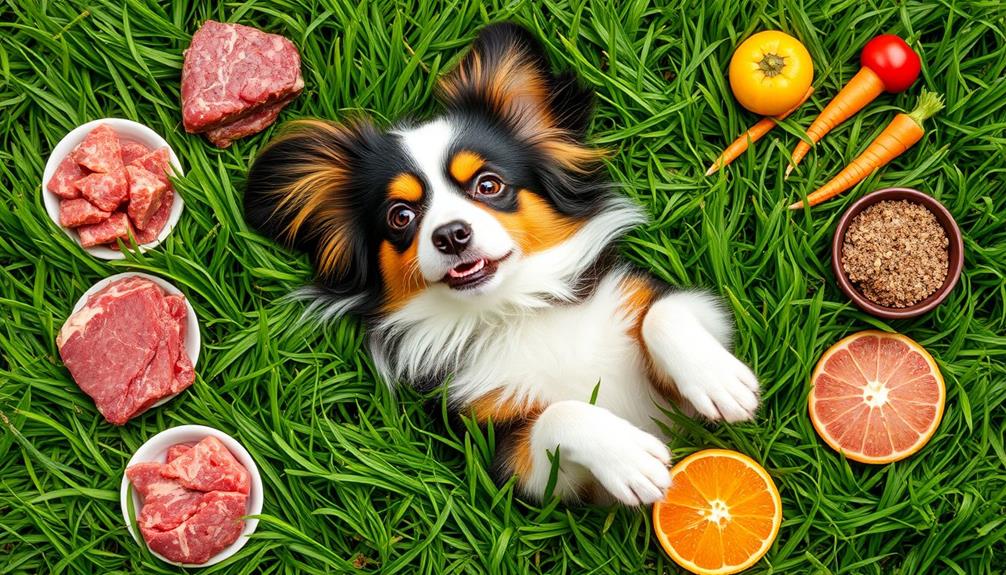
A raw food diet can greatly enhance your dog's skin and coat, providing them with a healthier, shinier appearance. One of the key benefits of raw feeding is the inclusion of essential fatty acids and amino acids, which play a vital role in maintaining ideal skin health. Studies show that up to 30% of dietary protein influences coat quality, leading to a shinier coat and reduced skin conditions.
The table below highlights the benefits of a raw dog food diet for skin and coat health:
| Benefit | Description |
|---|---|
| Enhanced Nutrient Absorption | Active enzymes in raw food improve nutrient uptake. |
| Reduced Skin Conditions | Addresses irritations and itchiness effectively. |
| Decreased Dandruff | Promotes moisture retention, reducing dryness. |
| Less Shedding | Healthier skin contributes to less hair loss. |
| Overall Coat Quality | A balanced, healthy diet leads to a glossy coat. |
Reduced Allergies
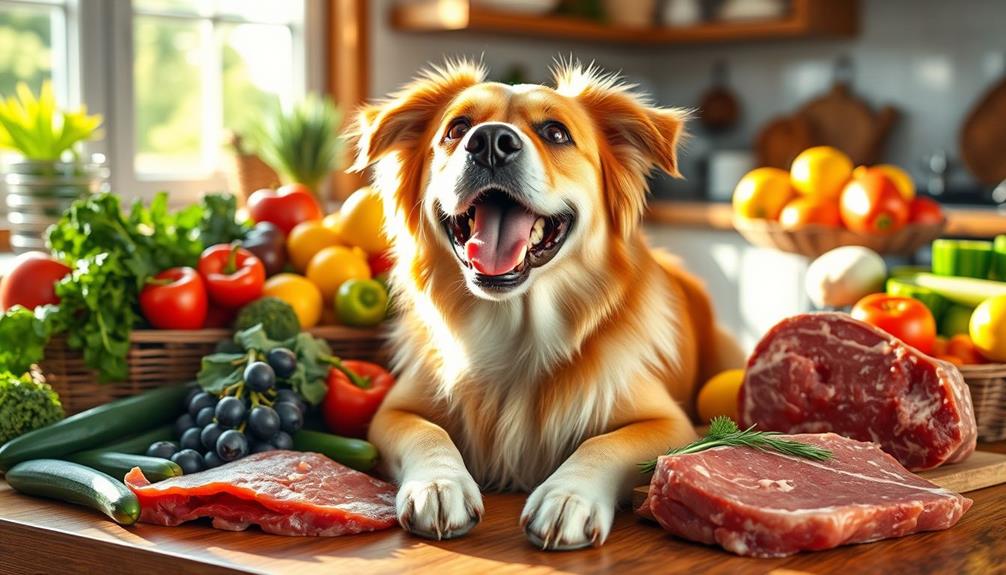
Raw food diets can considerably reduce allergies in dogs, offering a clear advantage for those suffering from food sensitivities. By shifting to raw dog food diets, you may notice significant improvements in your furry friend's health.
For instance, a more natural diet can promote a healthier gut environment, potentially reducing the likelihood of developing allergies and intolerances, similar to how essential oils like eucalyptus oil assist in maintaining overall health.
Here are some benefits to examine:
- Grain-Free and Gluten-Free: Raw diets typically eliminate common allergens like corn, wheat, and soy, which are often found in commercially prepared foods.
- No Fillers or Artificial Ingredients: This helps create a healthier gut environment, reducing the likelihood of nutritional imbalances and food intolerances.
- Quick Symptom Relief: Many dogs experience fewer allergy symptoms, such as skin rashes and ear infections, shortly after switching to a raw diet.
- Promoted Healthy Skin: A more natural and species-appropriate dog diet can lead to significant improvements in skin health, reducing itchiness and discomfort.
Stronger Immune System
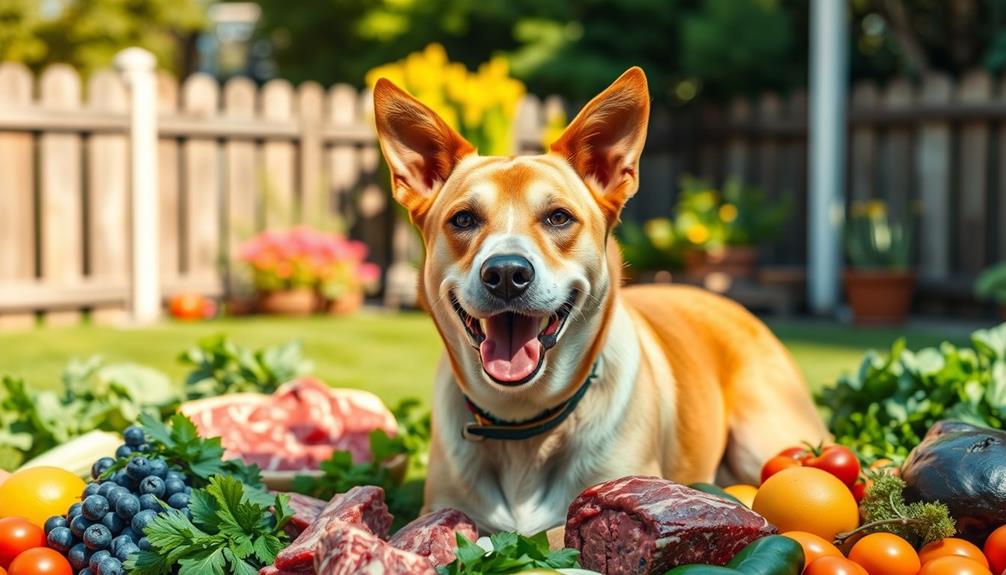
When you switch your dog to a raw food diet, you're not just changing their meals; you're enhancing their immune system.
The nutrient-rich ingredients improve gut health, which is essential since a healthy gut plays a significant role in immune function.
Key domains of development in psychology emphasize that environmental interactions, similar to dietary changes, can profoundly impact overall well-being.
As your dog's digestion improves, you'll notice better nutrient absorption, helping them fend off illnesses more effectively.
Nutrient Absorption Enhancement
Feeding your dog a raw food diet greatly enhances nutrient absorption, which plays an essential role in building a stronger immune system.
Raw diets provide higher bioavailability of essential vitamins and minerals, ensuring your dog gets the maximum nutritional value from their food. This is important since approximately 70% of the immune system is located in the gut.
Additionally, raw foods are often rich in antioxidants, similar to how Cranberry Juice Consumption benefits overall health.
Here's how raw feeding supports this:
- Quality Protein: Raw foods are rich in quality protein that strengthens immune function.
- Healthy Gut: Raw diets limit fillers and additives, promoting a healthy gut environment.
- Improved Digestion: Enhanced digestive processes lead to better nutrient absorption, which is essential for overall health.
- Robust Immune Response: Nutrient-rich raw foods help your dog respond to external threats and infections effectively.
Gut Health Improvement
A raw food diet can greatly boost gut health, which in turn strengthens your dog's immune system. When you feed your dog raw food, you provide easily digestible ingredients that enhance nutrient absorption. Since about 70% of the immune system is located in the gut, this improvement is essential for overall health.
Additionally, incorporating healthy dog snacks into your pet's diet can further support their digestive system and overall wellness. By avoiding fillers and artificial additives, a raw food diet minimizes the risk of food sensitivities and allergies, creating a healthier gut environment. This leads to better immune responses and fewer gastrointestinal issues. Your dog will likely experience fewer symptoms of food intolerances, indicating a stronger immune response linked to improved gut health.
Moreover, raw diets are rich in essential fatty acids and proteins, which support the growth of beneficial gut bacteria. These bacteria play a significant role in maintaining a balanced digestive system and further enhancing your dog's immune system.
Ultimately, a well-functioning gut contributes to reduced infections and illnesses, paving the way for a happier, healthier pet. By choosing a raw food diet, you're investing in your dog's gut health and overall well-being.
Better Dental Health
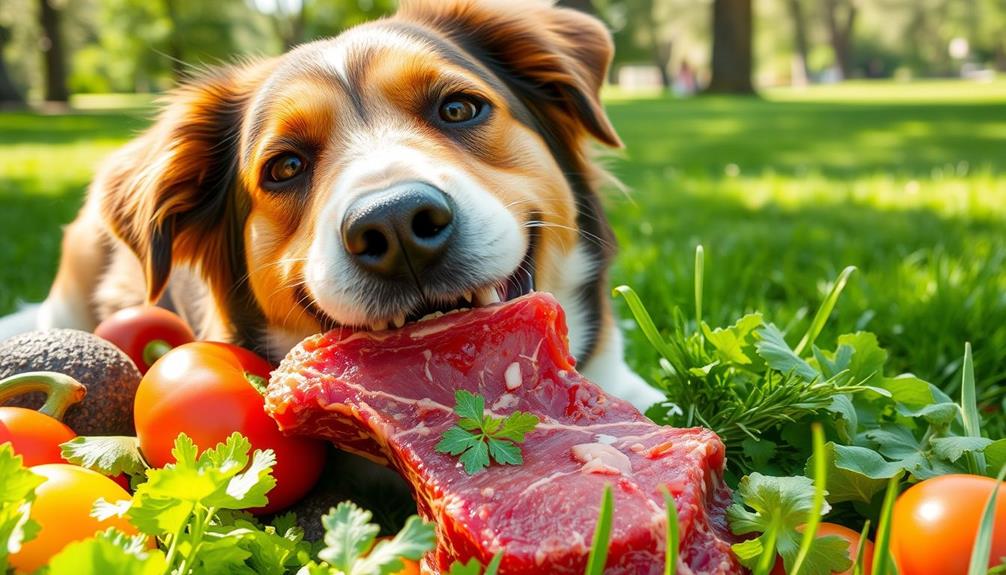
Switching to a raw food diet can greatly improve your dog's dental health. Chewing on raw meats and bones helps reduce plaque and tartar buildup while promoting healthier gums.
According to pet care guidelines, a proper diet can have lasting effects on overall well-being, including dental hygiene proper diet guidelines.
Plus, you might find that your dog's breath smells fresher, making this a win-win for both of you.
Natural Plaque Reduction
Over time, many dog owners have discovered the significant benefits of raw food for improving their pets' dental health. Shifting to a raw food diet can lead to natural plaque reduction and better oral hygiene for your furry friend.
Here's how it helps:
- Chewing Raw Meats: The act of chewing raw meats and meaty bones mechanically cleans your dog's teeth, reducing plaque and tartar buildup.
- Natural Enzymes: Raw food contains natural enzymes that combat harmful bacteria, promoting healthier gums and fresher breath.
- Strengthened Gums: Regular consumption of meaty bones not only reduces inflammation but also strengthens the gums, contributing to overall oral health.
- Quick Results: Many dog owners report noticeable improvements in their pets' dental health, with reduced plaque accumulation observed within weeks of changing to a raw food diet.
With over 75% of dogs experiencing dental disease by age 3, adopting a raw diet can serve as a practical alternative to brushing, enhancing your pet's oral hygiene and overall health.
Give your dog the gift of better dental health through natural plaque reduction!
Improved Gum Health
Improved gum health is another significant benefit of feeding your dog a raw food diet. By incorporating raw meaty bones into your dog's meals, you're not just providing a tasty treat; you're also helping to naturally clean their teeth. Chewing these bones reduces plaque and tartar buildup, which is essential since over 75% of dogs show signs of dental disease by age three.
Additionally, the natural enzymes present in the raw meat can contribute to fresher breath and enhanced dental hygiene, similar to how certain herbal teas, like chamomile and ginger, can promote overall well-being.
The abrasive action of chewing on raw meats and bones strengthens gums and promotes better oral health, leading to less inflammation and bleeding. This is a stark contrast to dogs fed commercial kibble, who often suffer from gum issues.
The natural enzymes found in a raw food diet also contribute to fresher breath and enhanced dental hygiene.
Switching to a raw food diet can serve as a practical alternative to traditional dental care, like brushing. Regular feeding of raw foods not only supports gum health but also makes it easier for you to maintain your dog's overall dental hygiene.
Investing in their oral health through raw feeding could save you from costly vet visits down the line.
Weight Management

Managing your dog's weight can be a challenge, but a raw food diet offers a practical solution. By feeding your dog raw pet food, you can help them achieve and maintain a healthy weight without the added sugars and fillers found in many commercial foods.
Additionally, understanding the importance of a budget for your pet's dietary needs can help you make informed choices when shifting to a raw diet.
Here are some key benefits of a raw diet for weight management:
- Biologically appropriate ingredients: Raw diets use whole foods that align with a dog's natural eating habits, promoting a healthy body condition.
- Non-glycemic vegetables: These help support metabolic health, making it easier to control weight and avoid excess pounds.
- Higher protein content: Raw diets typically include more protein, which aids in developing lean muscle while reducing body fat.
- Absence of calorie-loaded fillers: Without these unnecessary calories, your dog is less likely to gain weight, making it simpler to maintain an ideal physique.
With approximately 50% of dogs classified as overweight, shifting to a raw diet can greatly impact their overall well-being and weight management.
Increased Energy Levels

Switching to a raw food diet can greatly boost your dog's energy levels. Unlike commercial pet foods that often contain excess carbohydrates and sugars, a raw food diet contains nutrient-rich raw foods that provide stable energy sources. This helps prevent those pesky sugar spikes and crashes that can leave your dog feeling lethargic.
By embracing a more natural diet, you can also foster a transformative power of curiosity in your dog's behavior, encouraging them to explore and engage with their surroundings.
When you start feeding a raw diet, you might notice increased activity levels in your dog. Owners frequently report that their pets become more vibrant and playful after making the switch. The essential proteins and fats found in raw foods serve as effective energy sources, supporting your dog's overall health without taxing their digestive system.
Additionally, enhanced energy levels can improve cognitive function and focus, allowing your dog to engage better during training and playtime. With more energy to spare, your furry friend can enjoy life to the fullest, whether that means chasing a ball or exploring the great outdoors.
Smaller Waste Production

One of the notable benefits of a raw food diet is the significant reduction in waste production. When you switch to raw diets, you'll likely notice that your dog produces smaller, firmer stools. This is due to improved digestion and nutrient absorption from the easily digestible ingredients in raw dog food, which can be particularly beneficial for dogs with digestive issues or sensitivities related to certain commercial diets.
Additionally, the health improvements linked to a raw diet may contribute to overall emotional stability in pets, similar to the way emotional regulation can impact individuals with Borderline Personality Disorder.
Here are some key points to reflect on:
- Less Waste: Raw diets minimize fillers and hard-to-digest components found in many commercial pet foods, leading to a decreased overall volume of feces.
- Chalky Consistency: The waste generated from raw feeding is often chalky and decomposes more quickly, reducing environmental impact.
- Reduced Fecal Odor: You'll probably observe a noticeable decrease in fecal odor, as improved digestion results in less waste and fewer gastrointestinal issues.
- Less Frequent Stools: Dogs on raw food diets typically produce stools less frequently, making your clean-up routine easier.
Healthier Aging Process

Embracing a raw food diet can greatly enhance your dog's aging process, promoting vigor and energy levels that lead to a better quality of life. As dogs age, maintaining good health becomes essential, and a nutrient-rich raw food diet supports this by addressing common concerns in aging dogs.
One of the significant benefits of raw food is its ability to improve joint health. By reducing stiffness and pain, your senior dog can enjoy better mobility, making their golden years more active and enjoyable.
Additionally, the improved digestion that comes from a raw diet leads to firmer stools and fewer gastrointestinal issues, enhancing your dog's overall comfort.
A raw food diet also strengthens the immune system, helping older dogs fend off illnesses they may be more susceptible to.
Plus, with enhanced coat and skin health, you'll notice fewer irritations and conditions that often plague aging dogs, leading to a more vibrant appearance and increased comfort.
Frequently Asked Questions
What Are the Benefits of Feeding Your Dog a Raw Food Diet?
Feeding your dog a raw food diet can improve digestion, enhance their skin and coat quality, boost energy levels, support a healthier immune system, and help manage weight effectively, making your dog healthier and more vibrant. In addition to these benefits, raw food for dogs can also reduce the risk of allergies and intolerances, as well as decrease the likelihood of dental issues such as gum disease and tartar buildup. By providing a diet rich in natural, unprocessed ingredients, you can ensure that your dog receives the essential nutrients and enzymes they need for optimal health and well-being. Overall, incorporating raw food for dogs into their diet can lead to a longer, happier life for your beloved pet.
Are Dogs on a Raw Diet Healthier?
Yes, dogs on a raw diet tend to be healthier. You'll notice firmer stools, shinier coats, and increased energy levels. Their immune systems often strengthen, leading to a more vibrant and active lifestyle for your furry friend.
Do Vets Recommend a Raw Diet for Dogs?
Most vets don't recommend raw diets for dogs due to health risks like bacteria and nutritional imbalances. They emphasize balanced nutrition and safer feeding options to guarantee your dog stays healthy and thrives.
What Is Raw Dog Food Good For?
Imagine your dog thriving like a wolf in the wild. Raw dog food's great for digestion, skin health, energy levels, and dental care. You'll notice firmer stools, a shiny coat, and happier, more vibrant pup!
Conclusion
Feeding your dog raw food can transform their health like a butterfly emerging from its cocoon. With improved digestion, a shiny coat, and a stronger immune system, your furry friend will thrive. You'll notice reduced allergies, better dental health, and even a manageable weight. Plus, their energy levels will soar, and waste will shrink. Embracing a raw diet not only nurtures their body but also enriches their spirit, paving the way for a vibrant, healthier life together.

